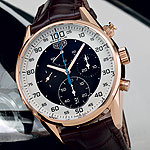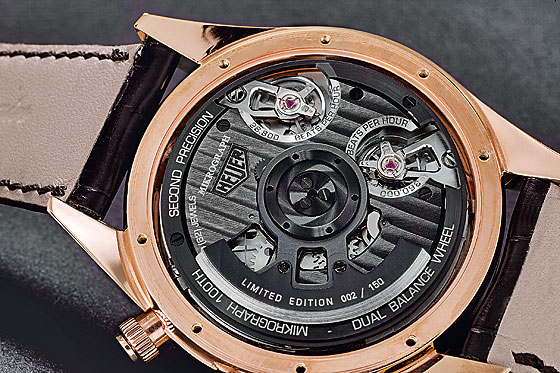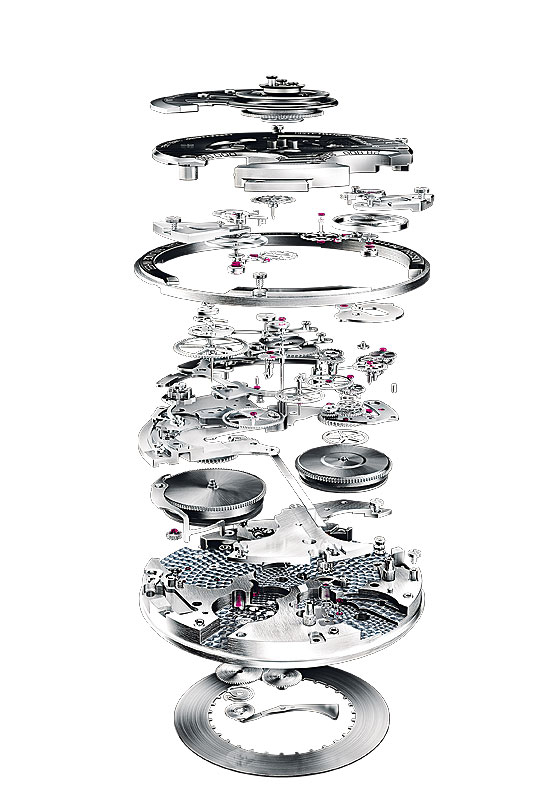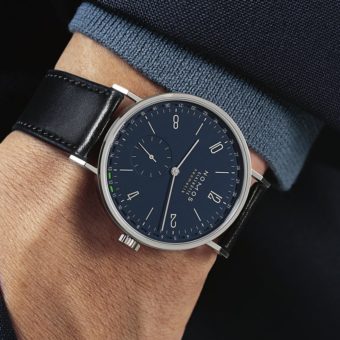
In 1916, Heuer Watch Co. introduced a hand-held stopwatch that represented a quantum leap in mechanical watch accuracy. At a time when the most precise chronograph measured 1/5 seconds, the Heuer Mikrograph measured intervals of 1/100 seconds. The Mikrograph established Heuer as the world’s leading producer of chronograph watches. Heuer’s Mikrograph stopwatches were the official timekeeper for the Olympic Games from 1920 to 1928. These stopwatches, which had 57-mm-diameter cases, continued to be built nearly unchanged, with or without split-seconds hands, until the mid-1960s.
Last year TAG Heuer introduced a fitting successor to the original Mikrograph. The new Carrera Mikrograph 1/100 is the first mechanical wristwatch that uses a central sweep-seconds hand to measure 1/100-second increments. The Mikrograph is not the first mechanical watch to time to the 1/100-second. That honor belongs to TAG’s Calibre 360 watch, introduced in 2006. For all its innovation (its chronograph module was made by La Joux-Perret and then added to an ETA 2892-2 movement), the rap on the Calibre 360 was that it was difficult to use due to the size of the display: 1/100s of a second are hard to read on the approximately 8-mm-wide subdial at 6 o’clock. Although this model was not designed for practical use, such as timing sporting events, it proved that a mechanical chronograph could measure 1/100s of a second. It was only a matter of time before TAG Heuer made a more practical model. The search for the Calibre 360’s successor led to an entirely new construction that took five years to develop.


The man behind the watch is the physicist Guy Sémon. Formerly employed in the aerospace industry, Sémon is currently vice president of Sciences & Engineering at TAG Heuer and the director of its research division in La Chaux-de-Fonds, Switzerland. Together with watchmaker Denis Badin and engineer Janick Chatelain, Sémon constructed an integrated chronograph. This new movement powers the Mikrograph 1/100. A major feature of this watch is its two different balance wheels, with separate escapements and transmission systems that allow you to run the chronograph without interfering with the watch movement. One balance, which oscillates at a speed of 4 hertz (28,800 vph), regulates the timekeeping movement, which has a 42-hour power reserve. The second balance, manufactured by Atokalpa, beats at a rate of 50 hertz (360,000 vph), and is responsible for the accuracy of the chronograph movement, which will run for a maximum of 90 minutes before needing additional energy. An arc-shaped scale, calibrated from 100 to 0 and positioned below 12 o’clock on the dial, shows the percentage of power remaining in the chronograph’s barrel. The movement has two separate barrels, assuring that both the time display and the chronograph have enough energy.

The timekeeping movement and the stopwatch are integrated into a single caliber, but they work independently of each other. Each draws its energy from its own barrel, and the power from each barrel is transferred along a separate pathway. The barrel that keeps the watch running is replenished through the conversion of kinetic energy from the blackened rotor of the self-winding movement. The chronograph’s barrel requires manual energy input, which is accomplished by turning the crown after it has been pulled out to its first position. The power-reserve display and a resistance that can be felt indicate that the device has been fully wound. The automatic movement can also be manually rewound by turning the crown counterclockwise. This means that the chronograph can continue to run after the watch has stopped and vice versa. This construction was necessary because even if the chronograph’s balance were designed to beat at a slower pace, coupling the stopwatch with the same energy flow that powers the watch would always cause the amplitude of the balance to decline abruptly and would detract from the accuracy of the watch.









whats prise of this watch